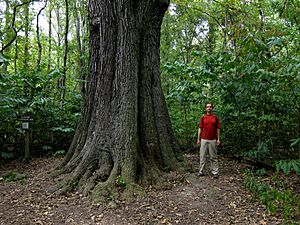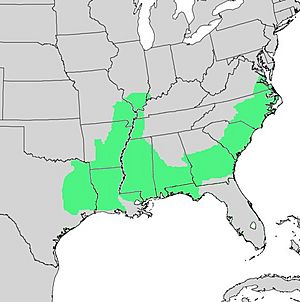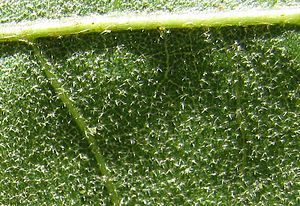Cherrybark oak facts for kids
Quick facts for kids Cherrybark oak |
|
|---|---|
 |
|
| Conservation status | |
| Scientific classification | |
| Genus: |
Quercus
|
| Species: |
pagoda
|
 |
|
| Range map | |
| Synonyms | |
|
List
Quercus carpenteri Riddell
Quercus falcata var. leucophylla (Ashe) E.J.Palmer & Steyerm. Quercus falcata var. pagodifolia Elliott Quercus falcata subsp. pagodifolia (Elliott) A.E.Murray Quercus leucophylla (Ashe) Ashe Quercus pagoda f. cocciniifolia Trel. Quercus pagoda f. juvenilis Trel. Quercus pagoda var. leucophylla (Ashe) Ashe Quercus pagodaefolia (Elliott) Ashe Quercus pagodifolia (Elliott) Ashe Quercus rubra var. leucophylla Ashe Quercus rubra var. pagodifolia (Elliott) Ashe |
|
The cherrybark oak, also known as Quercus pagoda, is a very important type of red oak tree found in the southern United States. It's bigger and grows straighter than the southern red oak. You'll often find it in places where the soil is a bit wet.
This tree is great for timber because its wood is strong and its trunk grows very straight. Many animals, like squirrels and deer, love to eat its acorns. Cherrybark oak also makes a beautiful shade tree for parks and yards. It used to be thought of as a type of southern red oak, but now scientists know it's its own species.
Contents
Where Cherrybark Oaks Grow
Cherrybark oaks are found in a few different areas, not all connected. They are common in the Carolinas and in the lower Mississippi Valley. However, they are rare in Georgia and Florida, which are in between these main areas. You can also find some scattered trees as far north as New Jersey and as far west as Texas and Oklahoma.
These trees usually grow in the best soil, often on well-drained hills near rivers or on sloped areas.
What Cherrybark Oaks Look Like
Flowers
Cherrybark oaks have both male and female flowers on the same tree. This is called being monoecious. The flowers appear in clusters called catkins. They grow from where the leaves meet the twig. Depending on where the tree is, flowers can show up from February to May.
Acorns
The acorns are about 0.5 inches long and round. A shallow, thin cap covers about one-third of the acorn. There are usually 200 to 750 acorns in a pound. These acorns take two years to grow and become ripe between August and November.
Cherrybark oak trees start making acorns when they are about 25 years old. They produce the most acorns when they are between 50 and 75 years old. Good acorn crops happen often, usually every 1 or 2 years. The acorns stay dormant (asleep) through winter and sprout in the spring. Their first leaves grow underground.
Size
Cherrybark oaks can grow very tall, often reaching 100 to 130 feet. Their trunks can be 3 to 5 feet wide. This makes them some of the largest red oaks in the South. They are also known for being very tough and growing quickly. They can grow well in more places than most other oaks found in wet areas. Their trunks usually grow about 3 to 6 inches wider every ten years.

Foliage (Leaves)
The name "pagoda" comes from the shape of the leaves. They look a bit like the stacked roofs of a pagoda building. The leaves are simple and grow alternately along the branch. They usually have V-shaped bases and deep cuts, forming 5 to 11 lobes. These lobes are not always perfectly opposite each other.
The leaves are 7 to 10 inches long and up to 7 inches wide. They are dark green, smooth, and shiny on top. The undersides are lighter and have tiny hairs, making them feel a bit fuzzy.
Twigs and Bark
The twigs are thick and brown or gray. They are hairy when they are young. The buds are shaped like eggs with a pointed tip and are also hairy. Sometimes, you might see small bumps called galls on the twigs.
The name "cherrybark" comes from how similar its bark looks to the bark of a black cherry tree. The bark is gray and has narrow, scaly ridges.
Similar Trees
In the past, the cherrybark oak was considered a type of southern red oak. However, scientists now know they are different. They have important differences in how they look and where they grow.
Cherrybark oaks prefer moist, low-lying areas. Southern red oaks usually grow in drier, higher places with poorer soil. The leaves of southern red oaks often have rounded (U-shaped) bases and fewer, more unevenly shaped lobes than cherrybark oaks. Also, their bark looks quite different.
How Cherrybark Oaks Grow
Cherrybark oaks can grow naturally in areas where they are protected from fire and animals eating them. These trees need a lot of sunlight to grow well. This means they often have to compete with other plants like weeds and vines. Young cherrybark oaks grow well in old fields with good, well-drained soil.
How many acorns are available is a big factor in how many new cherrybark oaks grow. Other things like the local weather, soil type, and how many other trees are around also play a role. Young trees need large open spaces to develop properly.
Cherrybark oaks are often found mixed in with other trees. They usually stand tall, either as the tallest trees or as tall as the tallest ones. They cannot handle being overshadowed for very long. They need lots of sunlight and probably only start growing in open areas.
Cherrybark oaks can easily mix with willow oaks (Quercus phellos). When they do, they create a new type of tree called the Louisiana oak (Quercus x Ludoviciana). Unlike the southern red oak, the cherrybark oak is a bit less resistant to very cold weather.
Uses of Cherrybark Oaks
Cherrybark oaks usually have a long, straight trunk without many branches. This is different from other oaks found in wet areas, like water and willow oaks. Because of its good shape and quality, cherrybark is considered one of the best red oaks for wood.
The wood is heavy, hard, and has a coarse grain. It is used for things like interior finishing, thin wood sheets (veneer), general construction, furniture, and cabinets. The wood itself is a light reddish-brown color.
Many animals rely on cherrybark acorns for a big part of their food. Common animals that eat them include gray and fox squirrels, white-tailed deer, raccoon, and many birds. Some of these birds are wild turkey, blue jay, wood duck, and common grackle.
Images for kids



